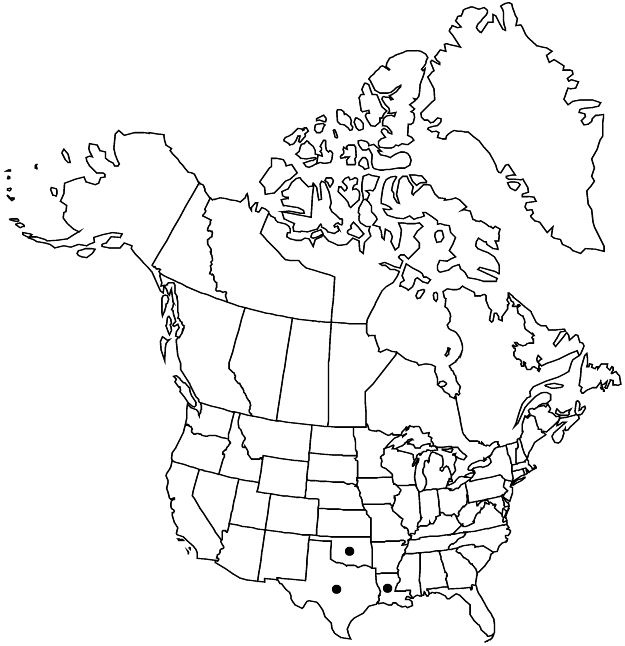Difference between revisions of "Linum imbricatum"
Field & Lab. 25: 32. 1957.
FNA>Volume Importer |
FNA>Volume Importer |
||
| Line 31: | Line 31: | ||
|elevation=0–400 m. | |elevation=0–400 m. | ||
|distribution=La.;Okla.;Tex. | |distribution=La.;Okla.;Tex. | ||
| − | |discussion=<p>Linum imbricatum stamens have red filaments and yellow pollen and anthers, a very showy combination against the broadly bowl-shaped, butter yellow corollas often with a broad, wine red base. The stems are terete proximally and strongly ribbed distally; the sepals persist even in fruit. Linum imbricatum occurs in southern Oklahoma, is scattered in Texas, and is known from one report from Acadia Parish, Louisiana.</p> | + | |discussion=<p><i>Linum imbricatum</i> stamens have red filaments and yellow pollen and anthers, a very showy combination against the broadly bowl-shaped, butter yellow corollas often with a broad, wine red base. The stems are terete proximally and strongly ribbed distally; the sepals persist even in fruit. <i>Linum imbricatum</i> occurs in southern Oklahoma, is scattered in Texas, and is known from one report from Acadia Parish, Louisiana.</p> |
|tables= | |tables= | ||
|references= | |references= | ||
| Line 55: | Line 55: | ||
|publication year=1957 | |publication year=1957 | ||
|special status=Endemic | |special status=Endemic | ||
| − | |source xml=https://jpend@bitbucket.org/aafc-mbb/fna-data-curation.git/src/ | + | |source xml=https://jpend@bitbucket.org/aafc-mbb/fna-data-curation.git/src/8f726806613d60c220dc4493de13607dd3150896/coarse_grained_fna_xml/V12/V12_178.xml |
|genus=Linum | |genus=Linum | ||
|section=Linum sect. Linopsis | |section=Linum sect. Linopsis | ||
Revision as of 14:44, 18 September 2019
Herbs, annual, 3–30 cm, glabrous proximally, conspicuously short hirsute distally with stout-based hairs. Stems spreading to ascending or erect, branched from base. Leaves: proximalmost opposite, middle and distal alternate, closely imbricate, proximal leaves spreading-ascending, distal strongly appressed; stipular glands absent; blade linear-lanceolate, 5–9 × 0.5–1.2 mm, margins entire, distal leaves sparsely ciliate, apex short-awned; midrib cartilaginous. Inflorescences panicles; bracts ciliate. Pedicels 2–11 mm. Flowers: sepals persistent, ovate, 4.2–6.1 mm, margins broad, purplish, scarious, prominently toothed distally, not glandular-toothed, apex conspicuously awn-shaped; petals yellow, with or without dark red base, obovate, 6.5–8 mm; stamens 5 mm; anthers 0.6–1.2 mm; staminodia absent; styles connate to within 0.3–0.8 mm of apex, 2–4.3 mm; stigmas capitate. Capsules broadly ovoid, 2.6–3 × 2.9–3.3 mm, apex rounded, dehiscing into 5, 2-seeded segments, segments persistent on plant, false septa hyaline, with cartilaginous portion conspicuously broader near base, proximal margin appressed-pilose, otherwise glabrous. Seeds 2–2.6 × 1.1–1.5 mm. 2n = 30.
Phenology: Flowering Apr–May.
Habitat: Sandy or rocky open ground.
Elevation: 0–400 m.
Distribution

La., Okla., Tex.
Discussion
Linum imbricatum stamens have red filaments and yellow pollen and anthers, a very showy combination against the broadly bowl-shaped, butter yellow corollas often with a broad, wine red base. The stems are terete proximally and strongly ribbed distally; the sepals persist even in fruit. Linum imbricatum occurs in southern Oklahoma, is scattered in Texas, and is known from one report from Acadia Parish, Louisiana.
Selected References
None.